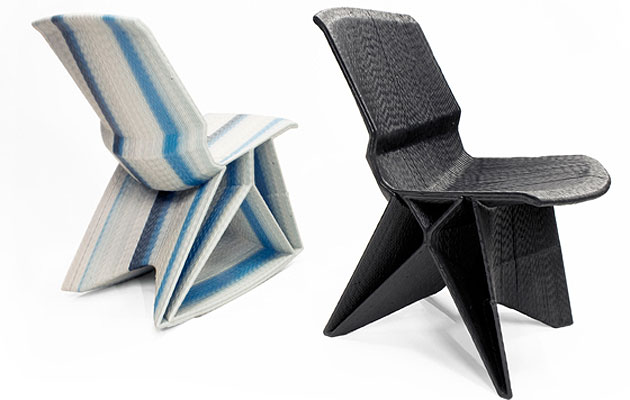|
|
||
|
Dirk van der Kooij Currently part of the Brit Insurance Designs of the Year exhibition at the Design Museum in London, Endless is produced using recycled plastics which have been made into flakes, then melted down and blended with pigment. Fanuc then squirts out an endless piece of plastic string, building one layer upon another to create the chair. Van der Kooij is now taking the concept further. “Before I do anything else I want the technique to be perfect. I want to make it more affordable because the technique is asking for it. It would be a shame if I don’t really engineer that aspect,” he says, adding that he wants to develop a robot that can make the chairs in different colour and stack them as well. The chair now retails at over €800, but the orders are still coming in. More than 100 pieces have been made so far and nowadays van der Kooij leaves Fanuc alone to get on with it. “Just before I finished my graduation project I worked day and night and at one point I fell asleep next to Fanuc,” he explains. “I didn’t yet trust the machine because it had made a few mistakes, so I was stressing, thinking it would be really messed up, but the chair came out perfect. It was really mind-boggling.” It takes three hours to make a chair but, with only one machine available, the creation of the Endless chairs is still very much a craft-based process. However, the first step towards larger scale manufacturing might only be around the corner as van der Kooij has been approached by the Dutch furniture producer Gispen to work with it on a project to be presented at the Milan furniture fair in April. “I still have to make it,” says van der Kooij. “I don’t have anything yet, so that will be interesting. But Fanuc is helping me.” (top image)
Laduma Ngxokolo The collection, which consists of knitted sweaters and cardigans in colourful patterns made from South African mohair and wool, was conceived as a response to a Xhosa initiation ritual. Traditionally, men underwent the circumcision ritual shrouded in boldly striped blankets but more recently blankets have been replaced by uniform V-necks from international fashion brands. “I’ve also undergone the Xhosa initiation ritual, but I felt that the clothing we wear afterwards no longer bears any resemblance to any of the tribe’s traditional clothing,” says Ngxokolo. Ngxokolo studied the traditional Xhosa patterns in a local museum and came up with 21st-century versions. He then created five different styles of sweater for his new Maxhosa line, which is gaining popularity outside the Xhosa tribe. “I am looking to expand. One of my focuses is export markets,” says Ngxokolo, who runs the production of the collection from his home with no financial support from the state. “There should be help available for us,” he insists. “In fact the government should assist emerging creatives more than the established businesses because we are the future.” A £1,000 prize from an international competition has helped Ngxokolo get to where he is today. But with interest from the domestic and international market, he has a lot of orders to fulfil on a tight deadline: “So many people want my knitwear and I’ve made a lot of promises. Now it’s time to deliver.”
Ben Fry One of Fry’s latest projects, employing his own software, is On the Origin of Species: The Preservation of Favoured Traces. It compares Charles Darwin’s six different editions of The Origin of the Species to each other, visualising the evolution of Darwin’s thinking on the subject of evolution itself. “It’s basically Darwin plus track changes,” says Casey. Traces, its shortened title, has made use of the website The Complete Works of Charles Darwin Online, which has transcribed Darwin’s work, word for word, from all six editions. Fry built software that “read” the text and aligned the different editions next to each other, showing where change had occurred.”I think that there’s something compelling about the story of how things are actually created and how we remember it collectively 150 or 200 years later,” says Fry. “For example, ‘survival of the fittest’ is something that we attribute to Darwin and his theory, but it doesn’t show up until the fifth edition of his book.” Darwin’s six editions were published over a period of 13 years and the word count went up from 150,000 to 190,000 so some very significant changes occurred in that time. “I was basically curious to see if there were things that you could do with this website to make it more educational,” says Fry. “It’s just such a massive amount of stuff to process and you want to home in on the stuff that’s interesting.” So Fry colour-coded the different texts, displaying them in narrow columns next to each other, highlighting the changes between each edition. There is something almost obsessive-compulsive about this kind of work – the need to order and make clear, but on no-one else’s instruction but your own. Still, in an information economy, the design of how we communicate complex information is going to play an increasingly dominant role, also outside the confines of the design world.
|
Image Dirk van der Kooij
Words Johanna Agerman Ross |
|
|
||



















